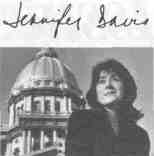STATE OF THE STATE
Lawmakers approved funds The first of April, some do say, is set apart for All Foolsf Day. But why the people call it so, nor I, nor they themselves do know. Poor Robin's Almanac, 1760 Gary Kelly feels like a fool. This superintendent of DuQuoin School District 300 is not the only one. Across Illinois, many parents, teachers, superintendents and school boards view the state's new school construction program as a farce, something befitting the April 1 deadline for grant applications. "I don't think they even knew what they were voting on," says Kelly of state legislators, who passed a $1.4 billion five-year program as part of an education spending bill during December's special session. At first glance, it looked as though lawmakers were finally going to ante up some major moola for school construction, something that has been needed since the last state-funded building program ran dry in 1981. "They told me we'd be really pleased," adds Kelly, whose southern Illinois grade school is a century-old, water-damaged mess. Local voters agreed last April to build a $9.2 million new one. In fact, Kelly's district waited to sell the bonds, hoping lawmakers would pass the program last spring. When they didn't, Kelly went ahead. As a result, DuQuoin is eligible only for a smaller debt service grant. So Kelly is not pleased. Neither are some superintendents at the other end of the state. Indeed, one of the fastest growing school districts, Indian Prairie School District 204, which educates students from Naperville, Aurora and Bolingbrook, is exploring a legal challenge, officials there admit. They're waiting, however, until the State Board of Education adopts permanent program rules, says Doug Gallois, District 204 assistant superintendent for business and finance. Until then, "we are optimistic" — optimistic the state may help defray the $80.5 million in bonds passed last February for four new elementary schools and two new middle schools. At presstime, though, Gallois' district wasn't eligible for any help because there is still room for students in the high school and the district isn't considered needy enough. But the rules — who's eligible for what — are fast-changing, thanks to pressure applied by some lawmakers and the public. "[Legislators] outlined the program when they drafted the bill, but they left a lot of the provisions vague and up to the state board," explains Ben Schwarm of the Illinois Association of School Boards, which is "very supportive of the concept" of the building bill. "Then, after the state board adopted rules, all of a sudden you had a bunch of not very happy legislators." Indeed, many downstate lawmakers, including Democratic Sen. Vince Demuzio of Carlinville, were upset that some of their poorer downstate schools were too small to qualify for aid. And several suburban lawmakers, including Republican Rep. Mary Lou Cowlishaw of Naperville, complained their growing schools weren't being allowed to count anticipated growth. "They'd have to demonstrate they actually had unhoused students," says Cowlishaw, who represents Indian Prairie, which has 3,600 more students than it did two years ago. The already embattled state board backed down and opened the program to nearly everyone. But one problem remains: No additional money has been added to the pot. The state is offering matching grants based on a school's financial ability. Total need, according to last year's survey, is an estimated $12 billion to $15 billion to build new classrooms or repair leaking roofs or solve other problems. The first deadline — for districts with March 17 building referendums — garnered requests for $685 million. The state's share of that is about $315 million, more than is likely to be available this fiscal year and next combined, says the state board. April Fool's Day was to be the program's final deadline, with about 230 more applications expected, says the board. Says Cowlishaw: "House Bill 452 was thrown together with baling wire." Further, she says, "The whole thing is political." In other words, she believes, the board rushed in with rules in order to help campaigning politicians. "Being able to point to ground actually being broken will do an incumbent legislator, particularly one from some downstate districts, a lot of good at the polls," she said shortly before the primary. Lawmakers hope to fix this mess through the rulemaking process, but a number of school construction bills have been introduced just in case. All Kelly knows for sure is that his district will be lucky to get $550,000 out of the deal. "I know now we can't count on the state. It's a lesson learned." 6 / April 1998 Illinois Issues |
||||||||||||||

